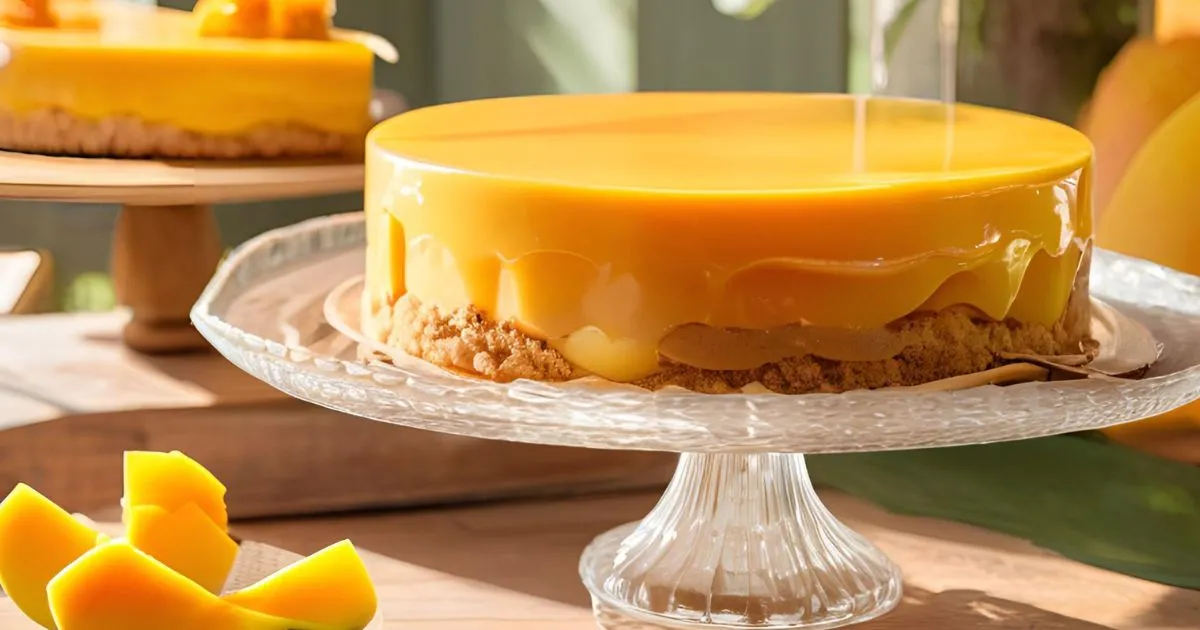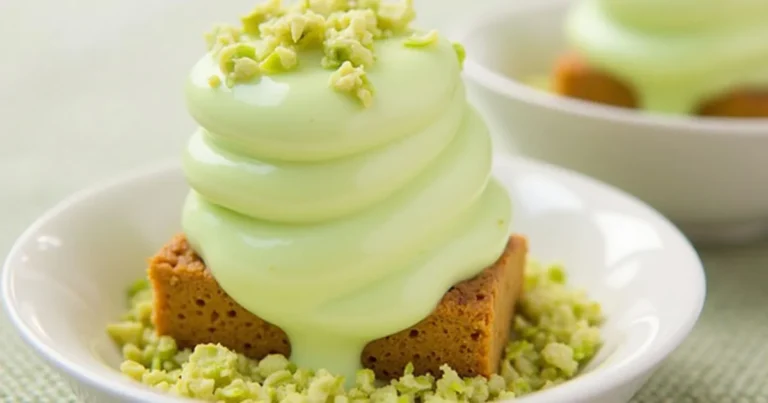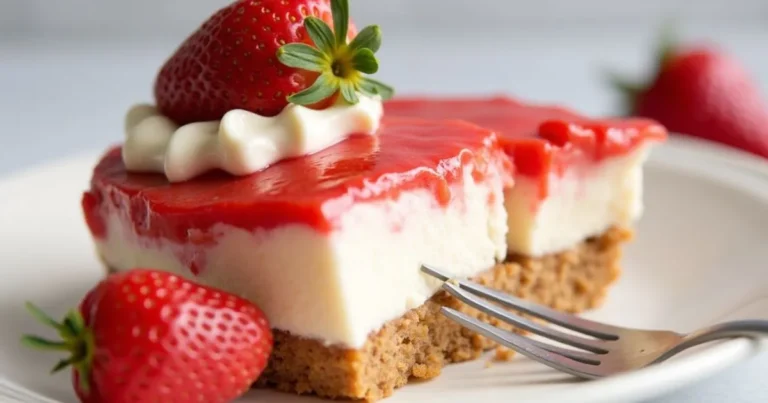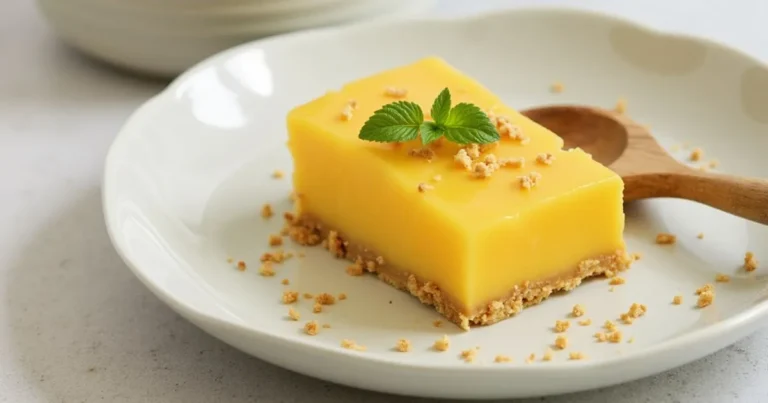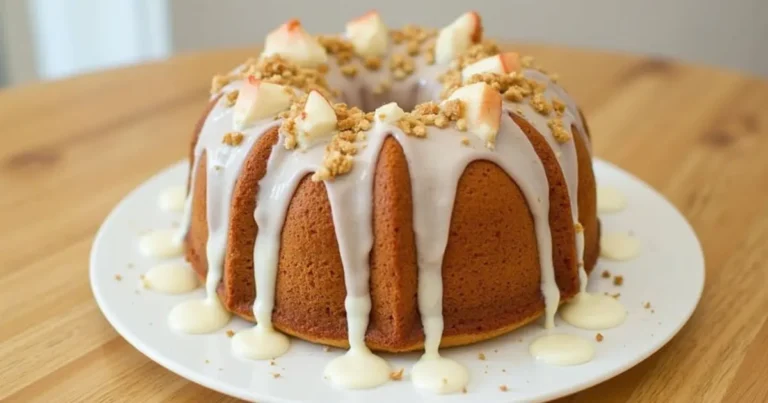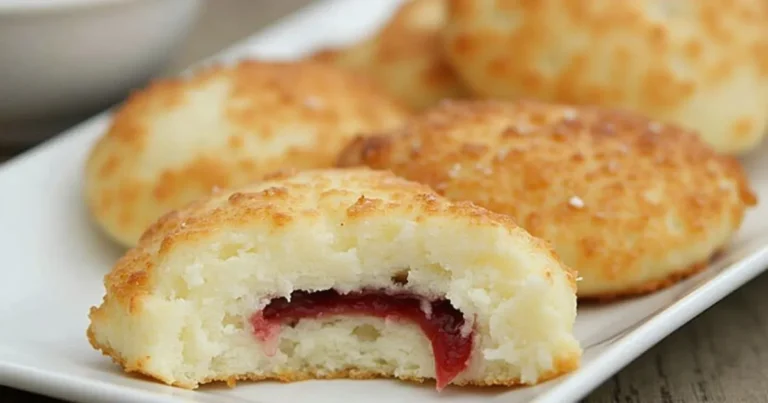Delicious Mango Mousse Cake Recipe That’s Creamy, Fruity, and Easy to Make
Have you ever tasted anything so divine that it carried you right away to another place? That is exactly what occurred last summer on my island vacation. The chef presented this vivid orange creation—a mango mousse cake that permanently altered my dessert expectations—that almost glowed in the sunset light.
One bite of that velvety smooth, powerfully fruity confection set me on a quest to replicate that enchanted moment right at home. Many tries later, I have developed a recipe that unexpectedly is quite friendly for home bakers of all kinds and captures that same tropical delight.
Sharing this particular mango mousse cake recipe is beautiful not only in terms of looks but also in terms of seeing the reactions of your loved ones as they taste something outstanding you made. Bringing a bit of paradise to a regular Tuesday dinner or turning a unique celebration with something very remarkable makes one quite happy.
Table of Contents
Why Will Your Go-To Dessert Be This Mango Mousse Cake
This recipe is unique among many others floating around the internet in one way. Harmonious balance. The ideal mango mousse cake strikes a careful balance between strong, tropical fruit flavor and rich creaminess, neither overloading the other. This dish offers amazing adaptability and achieves that harmony very nicely.
You want nothing more than not to turn on your oven when summer temperatures rise. Good news: this recipe calls for a no-bake variation ideal for those sweltering days when you still want something great. It’s perfect for entertaining since the make-ahead friendly approach lets you concentrate on your guests instead of last-minute dessert making.
This cake is perfect for special events—think anniversaries, birthdays, or dinner parties—but it’s simple enough for those times when you simply deserve something remarkable. The recipe guarantees you can create this tropical masterpiece regardless of season by working wonderfully with frozen mangoes as well as fresh mangoes at peak ripeness.
The Science Revealing the Ideal Mousse Texture
Building that cloud-like, melt-in-your-mouth consistency is science rather than only culinary magic. Whipped cream, fruit puree, and gelatin taken together produce a stable but ethereal form. While gelatin molecules form a delicate framework that preserves shape without sacrificing that unique silky mouthfeel, the small air bubbles caught in whipped cream give lightness.
The secret is harmony and technique. Too much gelatin produces a bouncy, rubbery texture more like that of childhood jello than of sophisticated mousse. Too little, and when sliced, your creation won’t hold its form. This recipe’s ratio has been painstakingly tested to get that ideal middle ground—firm enough to highlight beautiful layers, yet melts easily on your tongue.
Your Need: Tools & Ingredients
Ingredients for the Ideal Mango Mousse Cake
| Component | Ingredients | Quantity |
|---|---|---|
| Cake Base | Digestive biscuits or graham crackers | 250g |
| Unsalted butter, melted | 100g | |
| Sugar (optional) | 2 tbsp | |
| Mango Mousse Layer | Ripe mangoes | 3 large (about 600g pulp) |
| Gelatin powder | 2 tbsp | |
| Cold water | ¼ cup | |
| Heavy cream | 2 cups | |
| Powdered sugar | ½ cup | |
| Vanilla extract | 1 tsp | |
| Topping (Optional) | Fresh mango slices | 1 mango |
| Mint leaves | For garnish | |
| Passionfruit pulp | 2 passionfruits |
Vital Tools
Don’t let specialized equipment lists scare you; most kitchens already have shockingly simple tools needed in this recipe. You will need the following:
Though a regular cake pan lined with parchment extending up the sides works in a pinch, a 9-inch springform pan is more versatile.
- Electric mixer; just get ready for an arm exercise; a hand whisk also works!
- Food processor or strong ziplock bag and rolling pin to crush biscuits
- A spatula for light folding
- Measuring spoons and cups
- Perfect knife for mango cooking
Methodical Guide for Making Your Mango Mousse Cake
Getting the Perfect Cake Base Ready
The basis of your mango mousse cake should be given some thought; a well-made base offers structural integrity and textural contrast. Use these guidelines for basic excellence:
- 1. Put your biscuits in a food processor and pulse till you get a mixture like coarse sand. Little visible bits add great texture; hence, try not to overprocess into dust. No food processor? Crush biscuits in a sealed bag with a rolling pin.
- 2. Move crushed biscuits to a mixing bowl, then ladle melted butter on top. Mix until every crumb looks moistened; the mixture should hold together when pressed between your fingers without feeling unduly greasy.
- 3. Using the flat bottom of a measuring cup, firmly and equally press this mixture into your springform pan. Round the edges slightly to hold the mousse layer.
- 4. Chill for a minimum of twenty minutes before adding mousse. While guaranteeing correct base sets, this quick-chilling technique saves time.
Making the Luscious Mango Mousse
This is where tropical magic occurs—that is, where basic ingredients become silky perfection:
- Could say your final product will be much different depending on which perfect mango you choose. Search for fruits that emit a sweet scent close to the stem and yield just to light pressure. Although any ripe mango tastes great, Alphonso or Ataulfo varieties have especially good taste. Cut and peel your mangoes; then, blend until absolutely smooth.
- Correct activation of gelatin is vital. In a small bowl, evenly sprinkle gelatin over cold water; let it bloom for five minutes until it looks like translucent, swollen grains. Warm this mixture gently—microwave 10-second bursts or over a water bath—until completely liquid but not hot. If you find any grains, the dissolution is not entirely complete.
- Whip cold heavy cream in a separate bowl until soft peaks develop. Add powdered sugar and vanilla gradually, whisking constantly until medium peaks form; the cream should hold its shape while still showing a little droop at the peak tips. Watch carefully since whirling produces a grainy texture.
- Fold a tiny bit of mango puree into your gelatin mixture, then progressively add this to the other puree. This tempering process stops temperature shock that might set gelatin too soon.
- Instead of stirring, gently fold the mango mixture into whipped cream with a large spatula using a bottom-to-top scooping motion. This preserves those valuable air bubbles, producing the distinctive lightness of mousse. Till no streaks show themselves, keep on.
Assembly and Location
During these processes, patience guarantees picture-perfect results:
- Drizzle your wonderful mango mousse over the cold biscuit base, spreading it equally with your spatula to produce a smooth surface. Several times, lightly tap the pan against your counter to release any trapped air bubbles.
- Run a fresh paper towel around the inside rim of your springform pan to remove any mousse that might have crept up the sides during pouring, ensuring perfect edges when cutting.
- To allow correct setting, refrigerate for at least four hours, preferably overnight. Though waiting can be difficult, it pays handsomely for your patience.
- Run a thin knife around the inside edge of your springform just before releasing the clasp when ready to serve. Dip your knife in hot water and wipe dry between slices for especially clean cuts.
Ornamental Polishing Details
Your mango mousse cake becomes from great to amazing in the last presentation:
- Should start with Cut paper-thin mango pieces and spiral them to create beautiful mango roses. Start with a tight center coil and progressively add pieces, slightly overlapping each previous slice.
- Arrange fresh mango slices in concentric circles, starting from the outside edge and working inward, for simpler but equally striking decoration.
- Add opposing elements—a scattering of pistachios, delicate mint leaves, or passion fruit pulp—to improve visual appeal against the vivid orange mousse.
Expert Advice for Mango Mousse Cake Success
Typical Mistakes to Avoid
Even seasoned bakers sometimes trip over. Here’s how to avoid likely hazards:
- Making poor flavor and challenging mixing from mangoes that aren’t quite ripe.
- Whipping cream until it turns buttery rather than fluffy
- Hurrying the chilling process produces a mousse that slumps when cut.
- Add warm gelatin straight to cold cream; it will set in strings instead of spreading uniformly.
- Making a too-thick biscuit base that drowns delicate mousse flavors
Store Information and Make-Ahead
One of the best prepared-in-advance desserts is mango mousse cake:
While the base softens over time, complete cakes keep wonderfully refrigerated for up to three days.
- Individual components can be made separately; mango puree freezes brilliantly for up to three months, and biscuit base keeps for a week refrigerated.
Add fresh garnishes just before serving for the best presentation.
- Freezing finished cake works remarkably well; best texture results come from thawing overnight in your refrigerator.
Dietary Changes
Everybody should have amazing dessert experiences independent of dietary restrictions:
For vegetarian/vegan versions, substitute equal amounts of agar-agar powder for gelatin; although the texture will vary somewhat.
For the foundation, replace crushed gluten-free cookies mixed with almond flour or gluten-free digestives.
A dairy-free substitute for heavy cream, coconut cream whips wonderfully.
- Cut sugar to match less sweetness, especially when using very sweet mangoes.
Suggestions for Serving and Pairing
Consider careful accompaniments to enhance your mango mousse cake experience.
A glass of sparkling Moscato d’Asti makes a heavenly combination; its little sweetness and effervescence accentuate the tropical tastes exactly. Passion fruit iced tea or coconut water presented in elegant glasses offers cool counterpoints for non-alcoholic selections.
Present with a small dish of crushed pistachios or toasted coconut flakes that guests may sprinkle anyway they choose. Customizing with a drizzle of passionfruit coulis or white chocolate sauce brings visual drama.
Present unique individual portions on chilled plates with edible flowers and a quenelle of gently sweetened coconut whipped cream for a remarkable dessert experience for special events.
Why Readers Like This Mango Mousse Cake Recipe
“This recipe salvaged my daughter’s graduation celebration after our bakery order fell through. Guests thought I’d hired a professional pastry chef!” – Marina T.
“As someone who struggles with desserts, I approached this recipe nervously. The detailed instructions guided me to perfect results on the first attempt!!”—Darian K.
“I have tried many mango mousse recipes over the years, but this one achieves the ideal balance between richness and fresh fruit flavor.”—Sophia L.
Frequently asked questions on mango mousse cake
Could I create this mango mousse cake sans gelatin?
Certainly! Though texture varies somewhat from conventional gelatin, agar-agar powder makes a great plant-based replacement. Use an equal weight of agar-agar powder, but activate it differently—whisk it into your mango puree, bring it to a simmer for one to two minutes, then cool slightly before moving forward. Combining coconut cream with enough cornstarch also produces a stable framework for a less conventional approach.
Can I make this mango mousse cake far in advance?
Among the most make-ahead friendly desserts you know is this mango mousse cake. Though decorative items like fresh fruit garnishes should be added just before serving, the whole cake keeps its ideal texture and flavor for up to three days refrigerated. Individual components keep well for longer storage; the biscuit base refrigerated in an airtight container for a week, and the mango puree frozen for up to three months.
Why did my mango mousse cake not set as it should?
Different elements affect the appropriate setting. While incorrectly activated gelatin produces uneven texture, insufficient gelatin causes the mousse to collapse when cut. Make sure your gelatin blossoms completely in cold water before dissolving entirely. Another often guilty offender is overwhipping cream until it starts to lose structural integrity. At last, patience is crucial; allow a minimum of 4 hours refrigeration—probably overnight—for ideal setting.
Could I make this mango mousse cake using frozen or canned mangoes?
Although fresh mangoes taste best, both canned and frozen substitutes surprisingly work with little changes. Thaw fully and drain the extra liquid before blending frozen mangoes. To offset their usually sweeter character, drain completely and cut added sugar in your recipe using canned varieties. Either substitution produces a delicious treat that lets you taste tropical flavor all year long or seasonally.
How can one get the ideal mango mousse cake texture?
Achieving that ideal cloud-like consistency calls for attention to three fundamental elements: properly whipped cream (medium peaks—not too soft, not too firm), gentle folding technique (preserve air bubbles), and correct gelatin ratio. Another key is temperature control; ingredients should stay constantly cool during cooking. At last, giving enough setting time lets those intricate molecular structures grow fully, producing the ideal slice that maintains its shape while melting luxuriously on the tongue.
When should I be ready to present my mango mousse cake?
Visual and tactile signals point to an ideal setting. A fingertip’s light pressure should cause the surface to feel solid with minimum indentation. When the pan is gently tipped, the sides should seem set with no liquid movement. Usually, color deepens slightly as the setting advances. Insert a thin knife into the middle for absolute certainty; it should come clean with just a thin coating of mousse instead of dripping liquid. Remember that, almost always, overnight refrigeration produces better results than minimum chilling times.
Your Road Trip Through Mango Mousse Cake
Now you have every secret, trick, and troubleshooting advice required to make a mango mousse cake on par with top-notch pastry shops. This dessert generates unforgettable events and celebrations worth savoring, not only fulfills sweet cravings.
While the surprising simplicity of preparation is still your great secret, the vivid color, tropical scent, and sophisticated textures turn everyday events into unique opportunities. As seasons change, think about trying several fruit varieties—passion fruit, strawberry, or coconut produce equally amazing results using the same consistent methods.
We would dearly love to see your amazing works! Tag us on social media with #MangoMousseMagic, or leave comments below sharing pictures of your mango mousse cake masterpieces. Concerns about troubleshooting or adaptations? Our baking community offers creative ideas and a kind of help.
Save this mango mousse cake recipe for your next celebration, weekend project, or occasion when regular dessert just won’t be sufficient. After they have requested seconds, of course, your friends and family will thank you!

